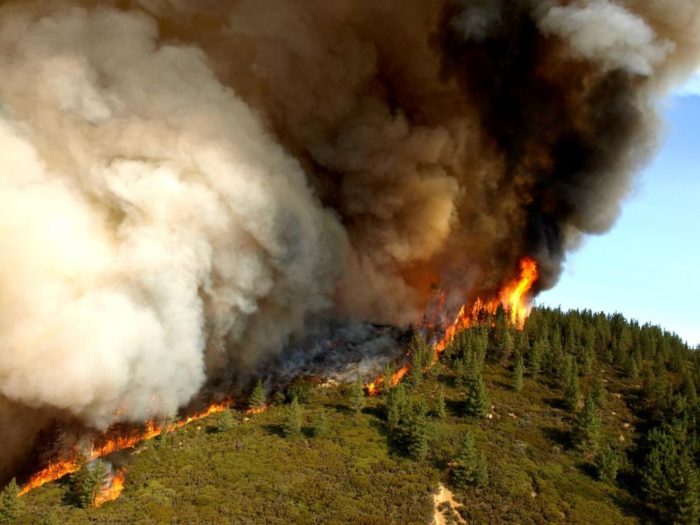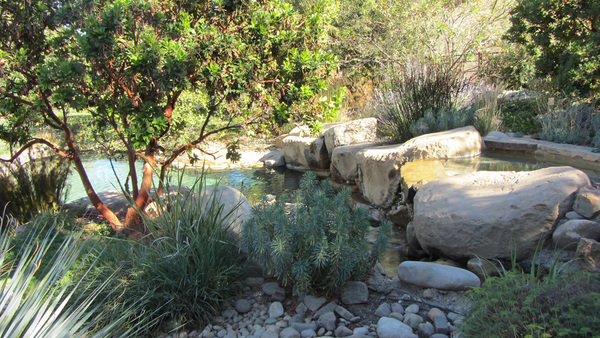
Fine Gardening’s Christine Alexander spoke with Douglas Kent this past spring to learn about landscaping tactics that can help protect a home from wildfire and about ways to speed a fire-damaged property on its way to recovery. Doug is an adjunct professor at Cal Poly Pomona, where he teaches ecological land management, ecological restoration, regenerative life-support systems, and landscape construction. He is also the author of the book Firescaping.
Christine Alexander: What is firescaping?
Douglas Kent: Firescaping is landscaping with two primary goals: (1) stop a fire close to a structure and (2) slow it further out.
The landscape immediately around a house is designed to be fire retardant. It can withstand intense heat and firebrands raining down on it for days, if not weeks—all without producing a flame.
Fifty feet or so from a structure, depending on the degree of slope, the goals of a landscape change: erosion control, biological diversity, and stormwater management play great roles. This zone is designed and maintained to dramatically slow a fire. This is the area where a fire fizzles out.
CA: How can firescaping help to protect your home?
DK: Wildfires are completely natural in wild areas, and the surest way to protect a home is to clear a landscape of excess fuels. After the 2003 Cedar Fire in San Diego County, where 2,820 homes were destroyed, the Los Angeles Times reported that 90% of the surviving homes had just 30 feet of clearance/defensible space.
CA: What plants are good to have around your home if you live in a wildfire-prone area?
DK: Plants within the first 30 feet of a structure are the most fire retarding; they might sizzle and wilt during a fire but will never produce a flame. Fire-retardant plants can catch and help extinguish firebrands. Maintenance is essential in the first 30 feet, and these plants require water, resources, and time.
Further out from a structure, fire-retarding plants give way to fire-resistant plants. This group requires much less water and care, yet can still maintain a high degree of fire resistance. Many of these plants also quickly resprout after injury, helping to reduce the chances of topsoil loss after a fire.
Please refer here for plant lists.
CA: If your land has been hit by a fire, what are some things you can do—for example, add soil amendments or plants—to help the landscape recover more quickly?
DK: I have written frequently on postfire recovery in both Northern and Southern California. Below is the essence.
Erosion leaps as high as 200% following fires in urbanized areas. With this increase comes mass sedimentation and alteration of stream beds, as well as damage to property and infrastructure. In some cases, this leads even to injury and death.
Fires eliminate canopies, burn off leaf litter, and expose the soil. When there is nothing to slow or stop them, wind and water gain leverage. Soil gets shoved around as a consequence.
But the problem is not just the lack of protective cover. Recently burnt landscapes also have to contend with repellency. Fires cook the waxes that are natural to our soils. When these waxes cool, they coat the first inch of soil with a repellency layer, stopping water from infiltrating.
The consequences can be dire when the lack of protective cover and repellency are combined. Fire-scarred communities can produce incredible amounts of runoff and debris flow.
This runoff and debris can overwhelm stormwater drainage systems, leading to extensive erosion elsewhere. Worse still, debris flowing downslopes can overrun homes, businesses, and small communities. These types of events can, and do, lead to personal injury and death.
Immediate First Aid for Wildfire Hit Gardens
A well-planned and quick response to the threat of erosion is needed. Below are the first six things that must be done after a wildfire.
1. Drain water. Drainage systems will be clogged with debris after a fire. Water skipping out of drains, such as culverts, is a leading cause of erosion, fire or not. Roof gutters, street gutters, culverts, swales, infiltration and detention basins, small streams, and concrete waterways will need cleaning. This is the very first thing to do.
2. Divert sheeting water. The chances of topsoil loss dramatically rise if a landscape receives sheeting water from nearby features. Driveways, roadways, sidewalks, and parking lots are often designed to sheet their runoff to the landscape. If this is the case on your property, divert that runoff away from your landscape and toward the storm-drain system.
Sand bags, diversion ditches, staked boards, dry-stacked walls, and bales are the most common diversion devices.
3. Minimize traffic. Keep foot and equipment traffic off burnt landscapes. Activity on slopes will increase the likelihood of erosion by weakening a soil’s bonds, dislodging soil particles, and trampling newly sprouted plants. Activity on flat ground can compact the soil and lower its water-absorption rate, which increases runoff.
Instead, plan on working on an injured landscape only after a plan of restoration has been developed and all the materials and tools are ready for use.
4. Watering. A recently burned landscape absolutely needs water, but there are two distinct types: The first watering is aimed at breaking the soil’s repellency layer. This watering is superlight—no more than 1 gallon per 10 square feet. The goal is to water only the top quarter-inch of soil.
Once the repellency layer is broken, deeper waterings should begin. The goal is to get the water 4 inches deep and encourage seeds, roots, and surviving plants to sprout. Three to 5 gallons of water per 10 square feet is required. Water again only when the first 2 inches have dried.
5. Leave the mess. Do not clean your landscape—the debris on your injured site provides much-needed protection. The charred remains of plants and garden features protect the landscape from wind and water erosion, slow sheeting water, and help prevent the surviving seeds and plants from drying out. Do not remove debris until a restoration plan has been developed.
6. Encourage weeds. Any plant that sprouts after a fire should be encouraged. These plants are reducing the chances of topsoil loss. Weeds, or any unwanted plant, should not be removed until a restoration plan has been developed.
CA: How do you limit undesirable opportunist plants from taking over after a fire?
DK: An aggressive approach is needed after a fire, and after the threat of topsoil loss has passed, to combat the proliferation of unwanted plants. The most important thing to do is mow the plants before they set seed. Here are two longer-term strategies:
1. Employ aggressive plants. The most effective long-term strategy is to plant plants capable of outcompeting the weeds. Oftentimes these plants are native to the region, but not always.
2. Mulch. A thick layer of organic matter can dramatically reduce the amount of weeds in the short-term, but continual mulching over time can change a soil’s chemistry and favor unwanted plants. Mulch strongly to suppress weeds initially, but then taper off as the more durable aggressive plants take hold.
CA: Do you have a personal history with wildfire? Do you have any stories of how firescaping helped people avert damage to a home, or can you refer me to anyone who would be willing to speak with me about their personal experience?
DK: I have been on the front line of three wildfires. And yes, I have visited many communities throughout California after a fire. I have seen the effects of firescaping and the consequences of poor maintenance and planning. I have interviewed survivors of many fires and truly believe that proper home and landscape care can significantly increase (but not guarantee) the chances of survival during a conflagration.
Ways to help
Consider donating to relief efforts by going to California Community Foundation (a five-star organization on Charity Navigator) and donating to its Wildfire Relief Fund.
Here are other organizations to consider.
To learn more about firescaping
Doug Kent’s book, Firescaping, is available from Amazon.


















Comments
Log in or create an account to post a comment.
Sign up Log in